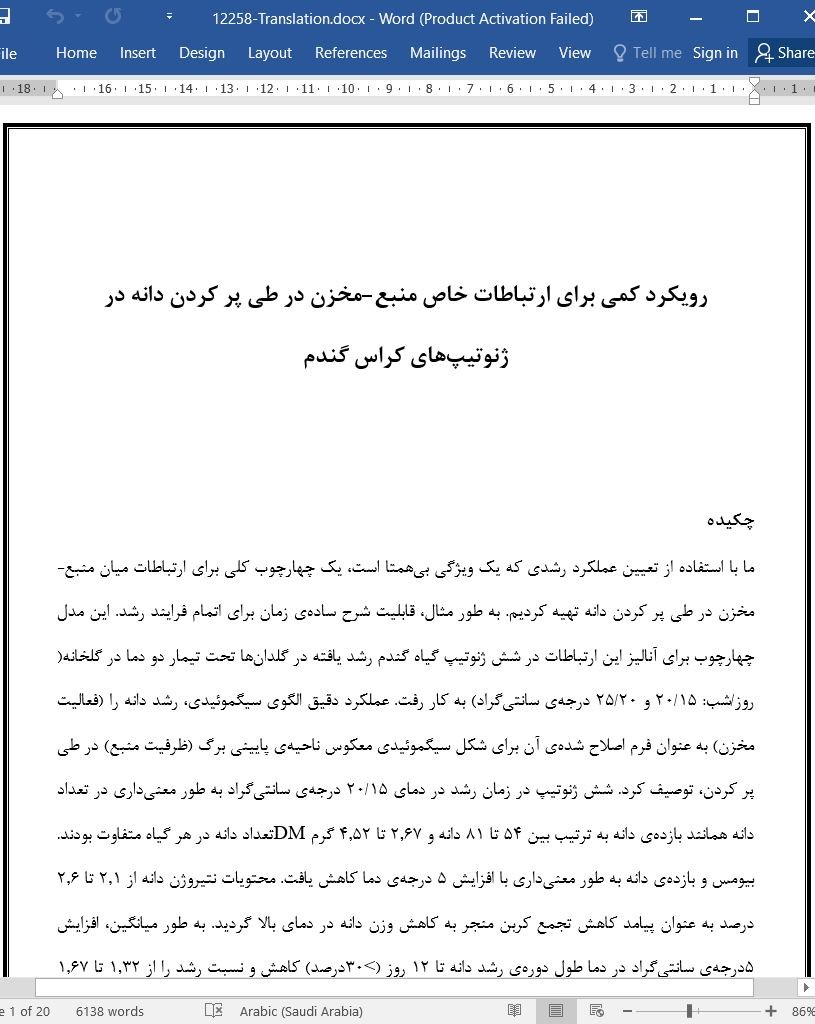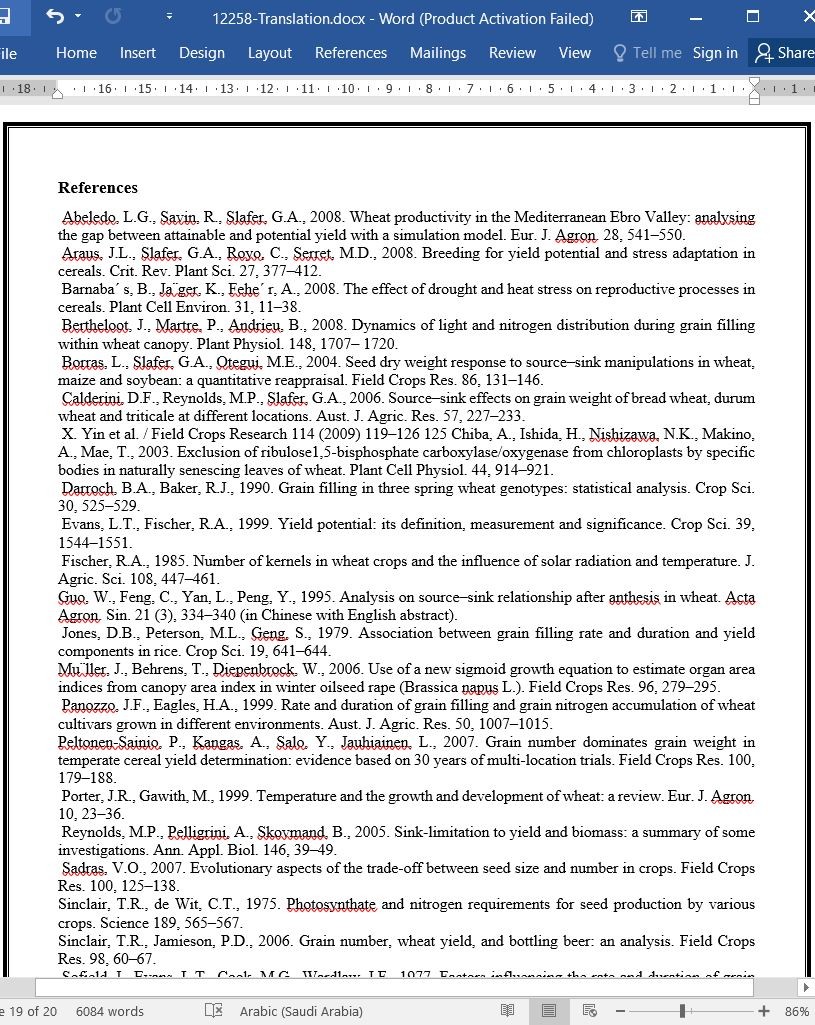
رویکرد کمی برای ارتباطات خاص منبع-مخزن در طی پر کردن دانه در ژنوتیپهای کراس گندم
چکیده
ما با استفاده از تعیین عملکرد رشدی که یک ویژگی بیهمتا است، یک چهارچوب کلی برای ارتباطات میان منبع-مخزن در طی پر کردن دانه تهیه کردیم. به طور مثال، قابلیت شرح سادهی زمان برای اتمام فرایند رشد. این مدل چهارچوب برای آنالیز این ارتباطات در شش ژنوتیپ گیاه گندم رشد یافته در گلدانها تحت تیمار دو دما در گلخانه( روز/شب: 15/20 و 20/25 درجهی سانتیگراد) به کار رفت. عملکرد دقیق الگوی سیگموئیدی، رشد دانه را (فعالیت مخزن) به عنوان فرم اصلاح شدهی آن برای شکل سیگموئیدی معکوس ناحیهی پایینی برگ (ظرفیت منبع) در طی پر کردن، توصیف کرد. شش ژنوتیپ در زمان رشد در دمای 15/20 درجهی سانتیگراد به طور معنیداری در تعداد دانه همانند بازدهی دانه به ترتیب بین 54 تا 81 دانه و 2.67 تا 4.52 گرمDM تعداد دانه در هر گیاه متفاوت بودند. بیومس و بازدهی دانه به طور معنیداری با افزایش 5 درجهی دما کاهش یافت. محتویات نتیروژن دانه از 2.1 تا 2.6 درصد به عنوان پیامد کاهش تجمع کربن منجر به کاهش وزن دانه در دمای بالا گردید. به طور میانگین، افزایش 5درجهی سانتیگراد در دما طول دورهی رشد دانه تا 12 روز (>30درصد) کاهش و نسبت رشد را از 1.32 تا 1.67 میلیگرم دانه در روز (20درصد) افزایش داد. اختلاف ژنوتیپ در دورهی پر کردن دانه نیز نسبت به رشد دانه بیشتر بود. تنوع ژنتیکی در ناحیهی پایینی برگ (نمایندهای برای ظرفیت به منظور ممانعت نوری و فتوسنتز) به طور مثبتی با اندازهی مخزن ارتباط داشت. آنالیز مدل نشان داد که زمان برای توقف پر کردن دانه و برای اتمام منبع پس از شکوفایی وابسته به دما بود. رویکرد کمی پارامترهایی که اختلافات ژنوتیپی خاصی در منبع پس از شکوفایی و ظرفیت مخزن در پاسخ به متغیرهای محیطی دارند، بررسی شده است.
4.3 صفات موثر عملکرد
ما در آزمایش گلدان خود با شش ژنوتیپ دریافتیم که عملکرد دانه بطور عمده با تعداد دانه در ارتباط است. به طور گستردهای گزارش شده است (مثل پلتنون-ساینیو و همکاران.، 2007) که در شرایط مطلوب، افزایش تعداد دانه کلید بهبود عملکرد ژنوتیپها است، اگرچه گفته میشود که افزایش تعداد دانه ممکن است در واقع نتیجهی عملکرد بالاتر نسبت به یک تعیین کننده باشد (سینکلیر و جیمیسون، 2006). تعداد دانه وابسته به مادهی خشک تجمع یافته قبل و بعد از شکوفایی است. صدراس (2007) اظهار داشت كه تعداد دانهها نسبت به منابع موجود پاسخ داده و متغیر است. دادههای منابع مختلف نشان میدهد که تعداد دانه در گندم تقریبا با مدل توزیع منابع عادلانه سازگار است (بوراس و همکاران.، 2004). حضور آسیمیلاتها پیش از شکوفایی بر رشد سنبلهها و گلها تاثیر میگذارد، این ترکیبات یکی از مهمترین عوامل محدود کنندهی تعداد دانه هستند. ترکیبات انباشته شده پس از شکوفایی، به ویژه در دورهی رشد جنین و دورهی تکثیر سلولهای آندوسپرم، به طور عمده بر رشد اولیهی دانهها و تنظیم دانهها تاثیر میگذارد (گو و همکاران.، 1995). بنابراین، افزایش تجمع آسیمیلات در زمان شکوفایی برای بزرگ کردن اندازهی مخزن و در نتیجه عملکرد دانهی بیشتر مفید است.
Abstract
We present a simple generic framework to quantify source–sink relationships during grain filling, by using a determinate growth function which has a unique property, namely being able of explicitly describing the time for the end of a growth process. This model framework was applied to analyze these relationships in plants of six wheat (Triticum aestivum L.) genotypes grown in pots in climate-controlled greenhouses under two temperature regimes (day/night: 20/15 and 25/20 °C). The function accurately described the sigmoid pattern of grain growth (sink activity), as its modified form did for the reversed sigmoid shape of flag-leaf area (source capacity), during grain filling. The six genotypes differed significantly in grain number as well as in grain yield, ranging from 54 to 81 grains and from 2.67 to 4.52 g DM per culm, respectively, when grown at 20/15 °C. Biomass and grain yield were significantly reduced by a rise of 5 °C. Grain nitrogen contents raised from 2.1 to 2.6% as a consequence of less carbon accumulation resulting in lower grain weights at the high temperature. On average, a rise of 5 °C in temperature reduced the duration of grain growth by 12 days (>30%), and increased the growth rate from 1.32 to 1.67 mg grain−1 d−1 (20%). Genotypic differences in grain-filling duration were also larger than in rate of grain growth. The genetic variation in the flag-leaf area duration (a proxy for the capacity for intercepting radiation and photosynthesis) was positively associated with sink size. Model analysis showed that whether or not the timing for the cessation of grain filling and for the end of post-anthesis source activity was synchronized depended on temperature. The quantitative approach yielded parameters that characterize genotypic differences of post-anthesis source and sink capacity in responding to environmental variables.
4.3. Yield component traits
We found in our pot experiment with six genotypes that grain yield was mainly associated with grain number. It has widely been reported (e.g. Peltonen-Sainio et al., 2007) that under favorable conditions, increasing grain number is the key to improve yielding ability of genotypes, although it has been argued that increased grain number may be considered more as a consequence of high yield than a determinant (Sinclair and Jamieson, 2006). Grain number is related to the accumulated dry matter before and after anthesis. Sadras (2007) stated that grain number is plastic and highly responsive to resource availability; data from various sources illustrate that grain number in wheat is roughly consistent with the model of equitable resource allocation (Borras et al., 2004). The availability of pre-anthesis assimilates affects the development of spikelets and florets, which is one of the major factors limiting grain number. Post-anthesis accumulated assimilates, especially during embryo development and endosperm cell proliferation period, affect mainly the initial development of grains and the setting of grains (Guo et al., 1995). So, raising assimilate accumulation around anthesis is beneficial to enlarge sink size resulting in a higher grain yield.
چکیده
1.مقدمه
2. مواد و روشها
2.1 مواد گیاهی و ارقام
2.2. تیمار دمایی
2.3 نمونهگیری و اندازهگیری
2.4 تجزیه و تحلیل مدل
3 نتایج
3.1 پارامترهایی برای توصیف پر شدن دانه
3.2 پارامترهایی برای توصیف ناحیه و طول دورهی پرچم برگ
3.3 سایر صفات
3.4 روابط بین منبع و مخزن
4. بحث
4.1 روش تحلیل روابط منبع و مخزن در حین پر کردن دانه
4.2. روابط مخزن و منبع در طول پر کردن دانه در شش ژنوتیپ گندم
4.3 صفات موثر عملکرد
منابع
ABSTRACT
1. Introduction
2. Materials and methods
2.1. Plant material and cultivation
2.2. Temperature treatments
2.3. Sampling and measurements
2.4. Model analysis
3. Results
3.1. Parameters to characterize grain filling
3.2. Parameters to characterize flag-leaf area and duration
3.3. Other traits
3.4. Relationships between source and sink
4. Discussion
4.1. Methodology of analyzing source and sink relationships during grain filling
4.2. Sink–source relationships during grain filling in six wheat genotypes
4.3. Yield component traits
References
- اصل مقاله انگلیسی با فرمت ورد (word) با قابلیت ویرایش
- ترجمه فارسی مقاله با فرمت ورد (word) با قابلیت ویرایش، بدون آرم سایت ای ترجمه
- ترجمه فارسی مقاله با فرمت pdf، بدون آرم سایت ای ترجمه



